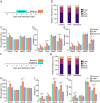This is a preprint.
High throughput machine learning pipeline to characterize larval zebrafish motor behavior
- PMID: 40667209
- PMCID: PMC12262660
- DOI: 10.1101/2025.06.17.660164
High throughput machine learning pipeline to characterize larval zebrafish motor behavior
Abstract
Using machine learning, we developed models that rigorously detect and classify larval zebrafish spontaneous and stimulus-evoked behaviors in various well plate formats. Zebrafish are an ideal model system for investigating the neural substrates underlying behavior due to their simple nervous system and well-documented responses to environmental stimuli. To track movement, we utilized an 8 key point pose estimation model, allowing precise capture of zebrafish kinematics. Using this kinematic data, we trained two random forest classifiers in a semi-supervised learning framework to classify various discreet behavioral outputs including stationary, scoot, turn, acoustic-startle like behavior, and visual-startle like behavior. The classifiers were trained on a manually labeled dataset, and their accuracy was validated showing high precision. To validate our machine learning models, we analyzed behavioral outputs during various stimulus evoked responses and during spontaneous behavior. For additional validation, and to show the utility of our recording and analysis pipeline, we investigated the locomotor effects of several established drugs with well-defined impacts on neurophysiology. Here we show that machine learning model development, enabled by semi-supervised learning developed classification models, provide detailed insights into the behavioral phenotypes of zebrafish, offering a powerful, high throughput method for studying neural control of behavior.
Keywords: behavior; high-throughput; kinematics; machine-learning; semi-supervised learning; zebrafish.
Conflict of interest statement
Conflicts of Interest The authors declare the following financial and personal relationships that may be considered as potential competing interests: J.E., V.S., M.W, and M.H. have a financial interest in Ramona Optics, Inc.
Figures





Similar articles
-
Leveraging a foundation model zoo for cell similarity search in oncological microscopy across devices.Front Oncol. 2025 Jun 18;15:1480384. doi: 10.3389/fonc.2025.1480384. eCollection 2025. Front Oncol. 2025. PMID: 40606969 Free PMC article.
-
Stabilizing machine learning for reproducible and explainable results: A novel validation approach to subject-specific insights.Comput Methods Programs Biomed. 2025 Sep;269:108899. doi: 10.1016/j.cmpb.2025.108899. Epub 2025 Jun 21. Comput Methods Programs Biomed. 2025. PMID: 40570739
-
Improving reliability of movement assessment in Parkinson's disease using computer vision-based automated severity estimation.J Parkinsons Dis. 2025 Mar;15(2):349-360. doi: 10.1177/1877718X241312605. Epub 2025 Feb 13. J Parkinsons Dis. 2025. PMID: 39973505
-
Falls prevention interventions for community-dwelling older adults: systematic review and meta-analysis of benefits, harms, and patient values and preferences.Syst Rev. 2024 Nov 26;13(1):289. doi: 10.1186/s13643-024-02681-3. Syst Rev. 2024. PMID: 39593159 Free PMC article.
-
Generalizable machine learning for stress monitoring from wearable devices: A systematic literature review.Int J Med Inform. 2023 May;173:105026. doi: 10.1016/j.ijmedinf.2023.105026. Epub 2023 Feb 28. Int J Med Inform. 2023. PMID: 36893657
References
-
- Naghizadeh M., Mohajerani M. H. & Whishaw I. Q. Mouse Arm and hand movements in grooming are reaching movements: Evolution of reaching, handedness, and the thumbnail. Behavioural Brain Research 393, 112732 (2020). - PubMed
-
- Kohatsu S. & Yamamoto D. Visually induced initiation of Drosophila innate courtship-like following pursuit is mediated by central excitatory state. Nat Commun 6, 6457 (2015). - PubMed
Publication types
Grants and funding
LinkOut - more resources
Full Text Sources
